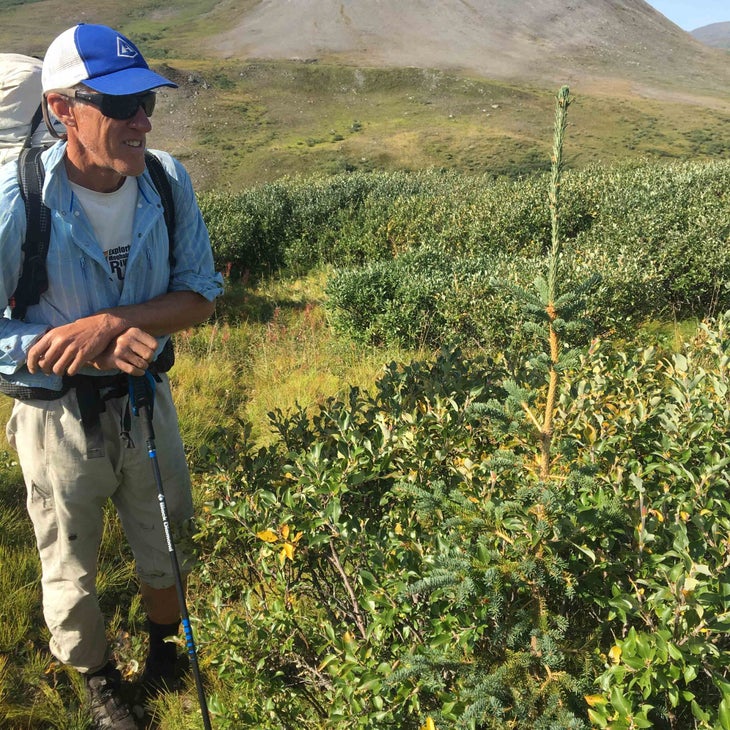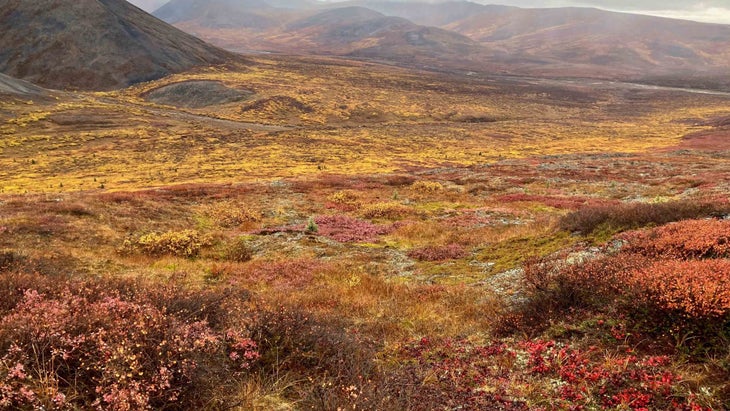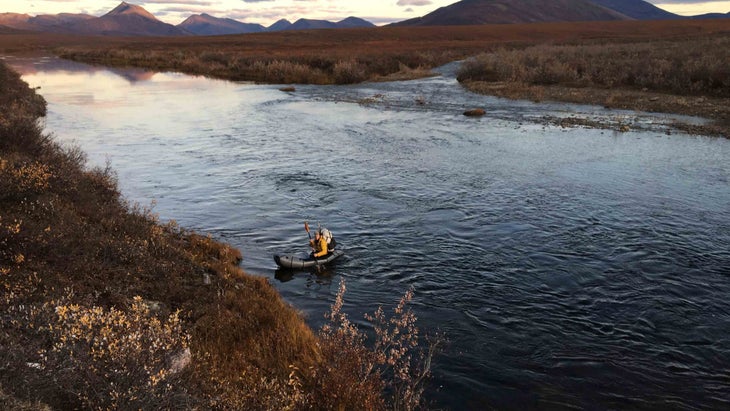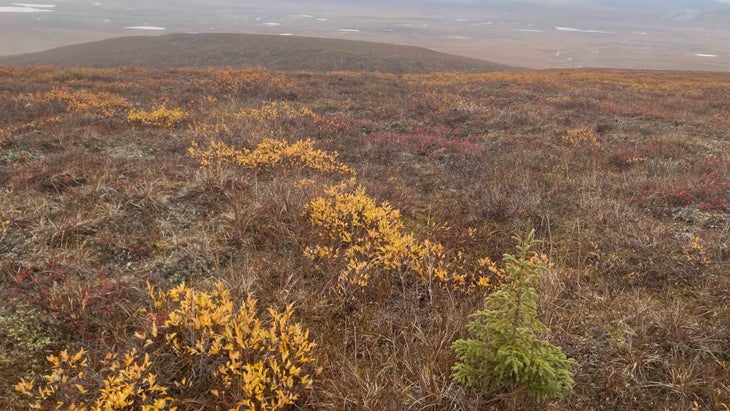We were pushing through head-high willows along a brushy caribou trail, five days into our week-long trek across Alaska’s Noatak valley, when my hiking partner, Brad Meiklejohn, startled me with a command.
“Stop!” he said. “Look to your left.”
I froze—nobody wants to hear a warning like that a hundred miles from the nearest road in the Arctic wilderness—and turned slowly, expecting to see our seventh and closest grizzly bear. Instead, I saw a chest-high white spruce tree.
The tree’s presence sparked concern of a totally different nature. It was growing in an area that, for thousands of years, had been too cold and inhospitable to sustain spruce trees of any size or species. And yet, here it was, healthy, strong, standing upright like a Christmas tree. The spruce’s presence was yet another sign of the long-term effects of climate warming on our planet.

Humanity’s climate-driven impacts show up most sharply at the remote ends of Earth: Antarctica, Greenland, the Tibetan Plateau, and other places with extreme environments. In the United States, the impact is clearest in the 35-million-acre complex of wildlife refuges and national parklands of the Brooks Range in Alaska. The climate here is warming three times faster than the global average.
For the last four years, the National Science Foundation has funded a collaborative project among the University of Alaska Anchorage (UAA), Amherst College, and Alaska Pacific University (APU) to study how spruce forests shift northward. The project was the idea of Paddy Sullivan, a research scientist at UAA, who wanted to uncover the role of soil nutrients (NPK) in tree line’s response to warming. The other partners are Becky Hewitt, an assistant professor at Amherst, who measures the soil fungi that provide tree roots with nutrients; Paddy’s postdoctoral researcher Colin Maher, who organizes and analyzes the data; and my grad student Russell Wong, who has collected more data in the field than the rest of us combined. I am a professor at APU, and my primary duty on the project is comparing historical aerial photos to recent satellite scenes to measure how fast spruce trees have advanced over the last four decades. But I get out, too.
Our field study focuses on 700 white spruce trees spread along 1,500 miles of mountains between Canada and the Chukchi Sea. Russell, Colin, and I have each been to nearly all 700 trees to set up experiments and collect data. Besides investigating the role of NPK in spruce growth at tree line, we install soil and air temperature dataloggers; collect tree rings; count cones, trees, and shrubs; characterize adjacent vegetation; and look for seedlings.

Our crew usually numbers about half a dozen, with APU undergrads, alums, other scientists, and even old adventure partners joining in as we walk and packraft, relying on air support to pre-place caches. We spend a month or two each summer covering 200-400 miles, although last year, with additional funding by NASA and the Explorers Club, we covered 900. “Pixel walking,” we call it, because the vegetation data we collect informs the satellites that detect change. Since the 1970s, satellites have detected “greening” in the Arctic, but just what the greening is must be determined from the ground.
We see firsthand the direct and indirect effects of the changing climate: permafrost slumps, drained lake beds, drying wetlands, drowning forests, creeks stained orange by iron crusts on stream-bottom rocks. We walk through beautiful landscapes, eerily empty of birds, mammals, and even mosquitoes, all for reasons yet unknown, but their population declines are worryingly coincident with rapid warming. In the western Brooks Range we dodge pushy grizzlies left hungry as an important food source, the Arctic ground squirrel, dwindle. The vegetation change is the most dramatic: tussocks drying up and dying; willow bushes doubling in height in the last five years; and, rarely seen before, “millennial” spruce, those that have germinated in the last 30 years, growing miles from any adult tree.
In July 2019, I was just back home from pixel-walking across the Arctic National Wildlife Refuge, entering field counts of seedlings onto spreadsheets, when I noted that a gap in field sites had left the pattern fuzzy. Hunched over and squinting at a detailed proprietary website of satellite scenes, I sorted through decades of imagery, and stumbled on a sharp, cloud-free, black-and-white image.

On a tributary of the upper Noatak, north of the Brooks Range divide that separates the boreal forest from Arctic tundra, were crisp shadows on snow. I couldn’t believe my eyes. The scene from late March 2018 showed what looked like spruce trees precisely where—according to a 2002 paper published in Arctic, Antarctic, and Alpine Research—none had grown since before the last glacial maximum, 20,000 years ago.
I called my longtime friend Brad and asked him to join me for a six-day walk followed by a two-day pack raft. Brad, a prolific packrafter with a master’s in botany, has been visiting the Brooks Range every year for three decades.
Seeing the spruce tree, Brad and I looked at each other.
“Holy shit, a spruce,” I said. “North of the divide!”
“What does that mean?” he asked.
“It means that those shadows on the satellite images are spruce trees. These spruce trees are reproducing and spreading where they haven’t been for thousands of years.”
“Is that surprising?”
“Well, no. And yes. For 30 years–about how long it takes spruce to grow enough to produce cones–people have been expecting climate change to push trees into tundra. But nobody’s really seen it yet!”
The 2002 paper had assumed that there were no spruce trees in the upper Noatak basin, because nobody had seen them. The area is so remote people rarely pass through, even then not noticing what they don’t expect.
I slipped off my pack, pulled out a tape measure, and handed Brad a notebook and pen.

I measured the sapling’s height, dropped to my knees, and began calling out the annual increments between bud-scars. Bud-scars, like external tree-rings arrayed at the top of a tree, encircle its stem marking the end of each year’s growing season. They offer a convenient way to estimate recent growth rates.
“OK: 1.53 meters tall. This year: 30 centimeters. Last year: 20 centimeters. Umm, 2017: 23 centimeters. 2016: 18 centimeters,“ I said.
The tree was a millennial, for sure, no more than 20 years old, and it had tripled in height over the last five years. This fast-growing tree was not struggling, like trees beyond tree line, but thriving.
We searched hard for more spruce in the tundra before heading into the Kobuk drainage, where we’d spend a night, then over another pass, returning to the Noatak basin in the morning.
Descending into the Kobuk we found no spruce above the thickets of alders and willows that grow beyond tree line. Maybe that sapling was an anomaly, I thought. Maybe there wasn’t really an invasion of tundra by spruce. Still, we hadn’t yet reached the area from the snowy satellite scenes.
The next day in blowing rain we fought through a jungle of willows and then, busting free of the brush at last and miles from any forest, entered the alpine zone of heather, moss, and lichen, and climbed toward the Kobuk-Noatak divide. That was when I spotted a cluster of hip- to knee-high millennials in the alpine tundra. These young spruce trees had “jumped” over head-high thickets of willows and alders and were essentially growing side-by-side with typical alpine plants, miles away and hundreds of vertical feet above spruce forests.
We geo-tagged photos of the trees and followed a line of young ones to the pass. Their numbers thinned as we reached the crest, then slowly increased as we descended into the Noatak basin. The millennials looked nothing like the scraggly dwarf trees a hiker finds at tree line in the Sierras, Rockies, or on Mount Washington. No, these trees looked as if they were being cultivated for Christmas duty: symmetrical, full, and with bright young growth at their tips.
Three miles beyond the pass and further north of the boreal-Arctic divide than any trees yet, we spotted a grove of adults and hurried over. Among the dozen trees standing ten t0 15 feet tall were some with cones. Scattered in the adults’ “seed shadows” were more millennials. I was shocked and, as a scientist, thrilled: here were adult trees producing cones, and young trees growing rapidly everywhere (later, with the expertise of Paddy and Colin, we’d learn that most of these adult trees were seedlings in the 1970s). As we walked, we saw thousands of spruce, a classic example of a rapidly growing population, a climate-driven invasion of tundra.
I felt compelled to stop and take measurements, to count, map and photograph as many as I could. But we still had 50 miles to walk and another 50 to packraft.
I knew I’d need to return with my crew to measure tree heights and ages, collecting data for statistical models to predict heights based on shadow length and ages based on height. The scientific community would want to know how far north the trees had spread, and how old the farthest northward trees might be. That way we could calculate their “migration rate” and estimate just when they had “jump-dispersed” over the mountains to get an idea of how fast boreal forests are moving in response to the accelerated warming of the Arctic climate.
I returned to those spruce woodlands with my grad student Russell and friend Ray Koleser, who had worked for 30 years as a forester. Together we collected tree cores, heights, and other data to calculate ages of thousands of adult trees over eight feet tall.
We estimate that a handful of seeds blew on winter winds from the Kobuk forests to the Noatak tundra during the early 1900s, carried over the mountains, skipping on snow. Once these earliest colonists matured and produced seeds, more trees grew, but slowly, particularly as it cooled during the 1950s. It wasn’t until the abrupt warming in the 1970s that this spruce population exploded, doubling every ten years and sending the latest recruits northwards a quarter mile per year.
These trees, encouraged by warmth, will further warm their surroundings. Their dark foliage absorbs sunlight, warming the air and ground. The warming of once carbon-rich tundra soils will increase decomposition, release more carbon dioxide, and so lead to more warming. Just as over the last 30 years, more sea-ice will melt, more open water will linger through the fall, adding moisture to the air and leading to the deepening winter snows that have already reduced the populations of ground squirrels, Dall sheep, and moose.
While weather changes from hour to hour and day to day, with some years warmer or wetter than others, the trends and changes that take place over decades and centuries are climatic ones. When every year brings an extreme event, they are no longer extreme. Never in civilization’s recorded history have changes as fundamental and drastic occurred so rapidly for so long.
Trees, whose lives advance at a pace similar to our own, signal that the Earth is changing in a long-term way. Just as we exhausted seemingly inexhaustible herds of buffalo and flocks of passenger pigeons, then polluted and depleted seemingly endless supplies of freshwater and clean air, we have now initiated a seemingly impossible feat: changing Earth’s climate.
Shifting forests that are advancing to the north while the southern edges are dying from fires, insects, and disease should give us pause. They tell us that big, long-lasting changes are underway. We may not be able to stop the changes, but we can slow them, and not by asking others to change their ways, but ourselves to change ours.
As published in Nature
Our research, “Sufficient conditions for rapid range expansion of a boreal conifer, was one of a handful of studies published in the scientific journal Nature this summer. The studies, in areas ranging from the Amazon to the Arctic, show climate’s effects on forests. See also: “Warm springs alter timing but not total growth of temperate deciduous trees” by Dow et al, “Even modest climate change may lead to major transitions in boreal forests” by Reich et al, “Direct evidence for phosphorus limitation on Amazon forest productivity” by Cunha et al, “Emerging signals of declining forest resilience under climate change” by Forzieri et al, and “Tropical tree mortality has increased with rising atmospheric water stress” by Bauman et al.
See also NASA’s videos on changing sea ice concentrations, illustrating the breakdown in one of Earth’s air-conditioning systems.